Clinical Reasoning: A Post-Caesarean Peritoneal Ileus Patient Care
VerifiedAdded on 2023/06/07
|13
|5000
|142
Case Study
AI Summary
This case study provides a detailed clinical reasoning assessment of a 29-year-old patient named Somalia who developed peritoneal ileus following a caesarean section. The report outlines the eight phases of the clinical reasoning cycle, including consideration of the patient's situation, collection of relevant information, processing gathered data, identification of problems, establishing goals, taking action, evaluating outcomes, and reflecting on the learning process. The assessment covers Somalia's symptoms, medical history, and the nurse's interventions, emphasizing the importance of understanding the pathophysiology and pharmacology of ileus to provide effective patient care and improve diagnostic accuracy. The study also highlights the significance of collaboration with healthcare professionals and continuous evaluation and reflection to enhance nursing practice.
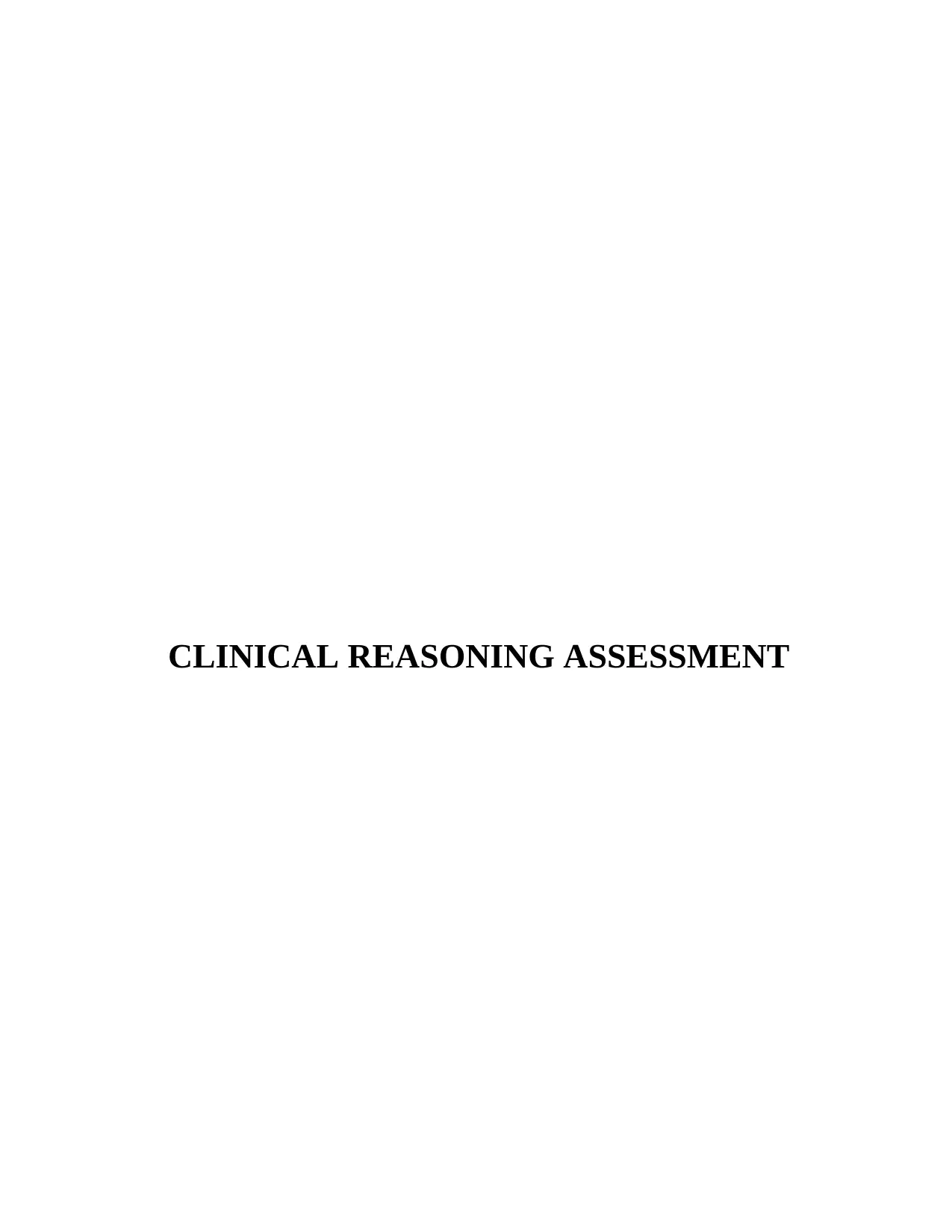
CLINICAL REASONING ASSESSMENT
Paraphrase This Document
Need a fresh take? Get an instant paraphrase of this document with our AI Paraphraser

Table of Contents
INTRODUCTION...........................................................................................................................3
MAIN BODY...................................................................................................................................3
The clinical reasoning cycle and their phase in the development process of 29 years Somalia
................................................................................................................................................3
Epistemology of practice........................................................................................................4
Consideration of facts in accordance with the Somalia situations:........................................4
Collection of information of patients having the peritoneal ileum:.......................................4
Processing of the gather information with the help of patient's data:....................................5
Identification of the problems................................................................................................6
Establishing the goals in the clinical reasoning of patients Somalia:.....................................7
Taking action process by the nurse in the post natal ward and in treatment process of Somalia:
................................................................................................................................................8
Evaluation of the Post Caesarean patients Somalia................................................................8
Reflection of the Clinical reasoning and new learning which has developed through this stage
................................................................................................................................................9
CONCLUSION:.............................................................................................................................10
REFERENCES..............................................................................................................................12
INTRODUCTION...........................................................................................................................3
MAIN BODY...................................................................................................................................3
The clinical reasoning cycle and their phase in the development process of 29 years Somalia
................................................................................................................................................3
Epistemology of practice........................................................................................................4
Consideration of facts in accordance with the Somalia situations:........................................4
Collection of information of patients having the peritoneal ileum:.......................................4
Processing of the gather information with the help of patient's data:....................................5
Identification of the problems................................................................................................6
Establishing the goals in the clinical reasoning of patients Somalia:.....................................7
Taking action process by the nurse in the post natal ward and in treatment process of Somalia:
................................................................................................................................................8
Evaluation of the Post Caesarean patients Somalia................................................................8
Reflection of the Clinical reasoning and new learning which has developed through this stage
................................................................................................................................................9
CONCLUSION:.............................................................................................................................10
REFERENCES..............................................................................................................................12
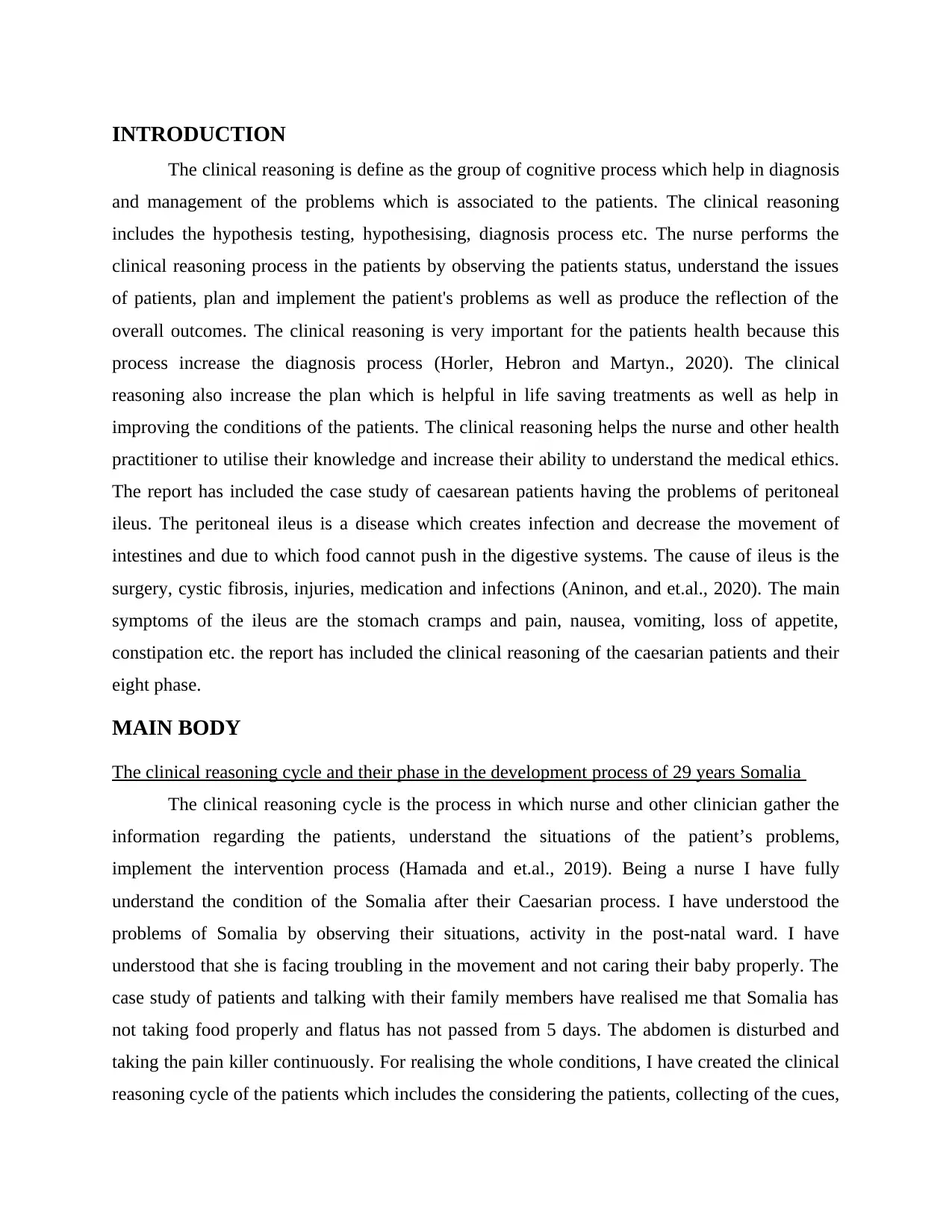
INTRODUCTION
The clinical reasoning is define as the group of cognitive process which help in diagnosis
and management of the problems which is associated to the patients. The clinical reasoning
includes the hypothesis testing, hypothesising, diagnosis process etc. The nurse performs the
clinical reasoning process in the patients by observing the patients status, understand the issues
of patients, plan and implement the patient's problems as well as produce the reflection of the
overall outcomes. The clinical reasoning is very important for the patients health because this
process increase the diagnosis process (Horler, Hebron and Martyn., 2020). The clinical
reasoning also increase the plan which is helpful in life saving treatments as well as help in
improving the conditions of the patients. The clinical reasoning helps the nurse and other health
practitioner to utilise their knowledge and increase their ability to understand the medical ethics.
The report has included the case study of caesarean patients having the problems of peritoneal
ileus. The peritoneal ileus is a disease which creates infection and decrease the movement of
intestines and due to which food cannot push in the digestive systems. The cause of ileus is the
surgery, cystic fibrosis, injuries, medication and infections (Aninon, and et.al., 2020). The main
symptoms of the ileus are the stomach cramps and pain, nausea, vomiting, loss of appetite,
constipation etc. the report has included the clinical reasoning of the caesarian patients and their
eight phase.
MAIN BODY
The clinical reasoning cycle and their phase in the development process of 29 years Somalia
The clinical reasoning cycle is the process in which nurse and other clinician gather the
information regarding the patients, understand the situations of the patient’s problems,
implement the intervention process (Hamada and et.al., 2019). Being a nurse I have fully
understand the condition of the Somalia after their Caesarian process. I have understood the
problems of Somalia by observing their situations, activity in the post-natal ward. I have
understood that she is facing troubling in the movement and not caring their baby properly. The
case study of patients and talking with their family members have realised me that Somalia has
not taking food properly and flatus has not passed from 5 days. The abdomen is disturbed and
taking the pain killer continuously. For realising the whole conditions, I have created the clinical
reasoning cycle of the patients which includes the considering the patients, collecting of the cues,
The clinical reasoning is define as the group of cognitive process which help in diagnosis
and management of the problems which is associated to the patients. The clinical reasoning
includes the hypothesis testing, hypothesising, diagnosis process etc. The nurse performs the
clinical reasoning process in the patients by observing the patients status, understand the issues
of patients, plan and implement the patient's problems as well as produce the reflection of the
overall outcomes. The clinical reasoning is very important for the patients health because this
process increase the diagnosis process (Horler, Hebron and Martyn., 2020). The clinical
reasoning also increase the plan which is helpful in life saving treatments as well as help in
improving the conditions of the patients. The clinical reasoning helps the nurse and other health
practitioner to utilise their knowledge and increase their ability to understand the medical ethics.
The report has included the case study of caesarean patients having the problems of peritoneal
ileus. The peritoneal ileus is a disease which creates infection and decrease the movement of
intestines and due to which food cannot push in the digestive systems. The cause of ileus is the
surgery, cystic fibrosis, injuries, medication and infections (Aninon, and et.al., 2020). The main
symptoms of the ileus are the stomach cramps and pain, nausea, vomiting, loss of appetite,
constipation etc. the report has included the clinical reasoning of the caesarian patients and their
eight phase.
MAIN BODY
The clinical reasoning cycle and their phase in the development process of 29 years Somalia
The clinical reasoning cycle is the process in which nurse and other clinician gather the
information regarding the patients, understand the situations of the patient’s problems,
implement the intervention process (Hamada and et.al., 2019). Being a nurse I have fully
understand the condition of the Somalia after their Caesarian process. I have understood the
problems of Somalia by observing their situations, activity in the post-natal ward. I have
understood that she is facing troubling in the movement and not caring their baby properly. The
case study of patients and talking with their family members have realised me that Somalia has
not taking food properly and flatus has not passed from 5 days. The abdomen is disturbed and
taking the pain killer continuously. For realising the whole conditions, I have created the clinical
reasoning cycle of the patients which includes the considering the patients, collecting of the cues,
⊘ This is a preview!⊘
Do you want full access?
Subscribe today to unlock all pages.

Trusted by 1+ million students worldwide
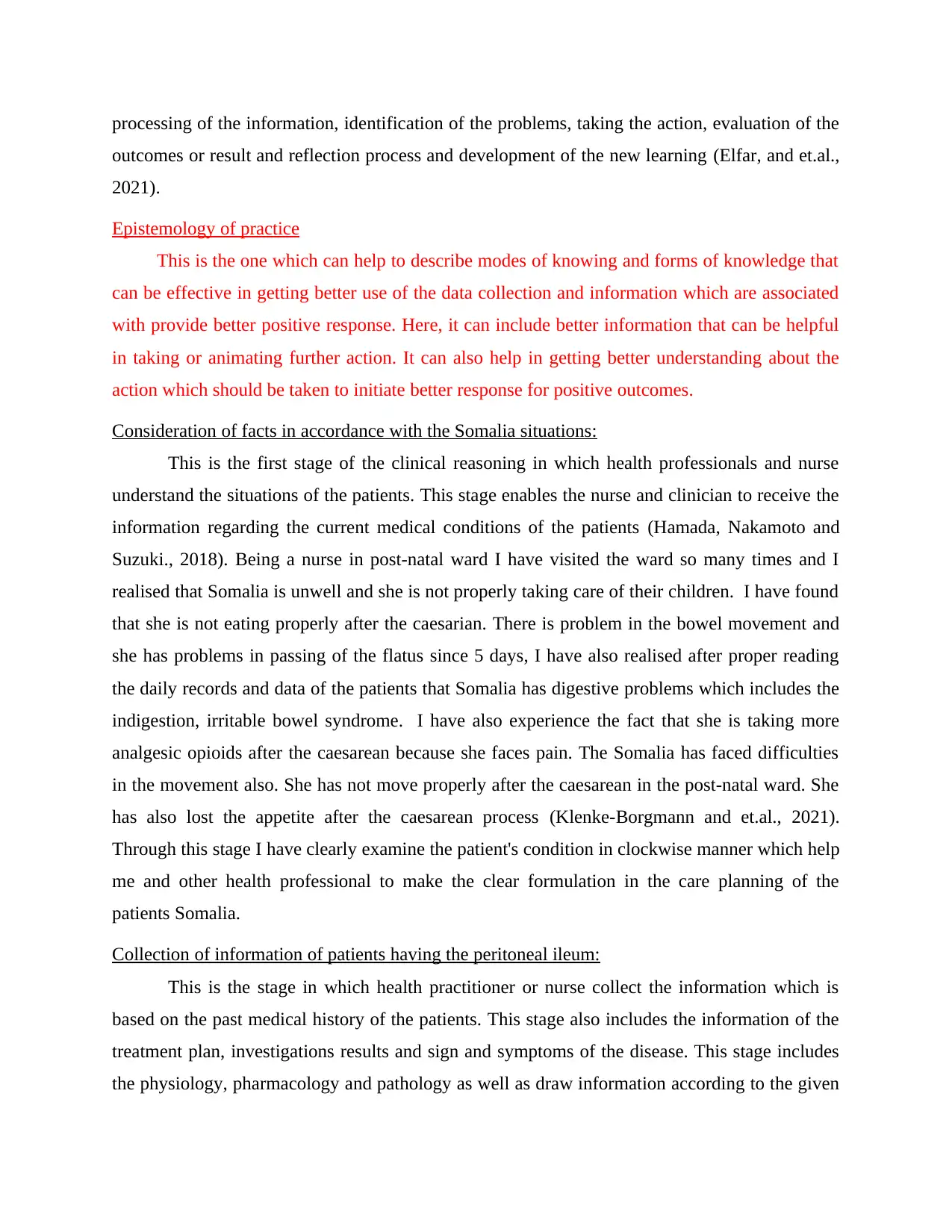
processing of the information, identification of the problems, taking the action, evaluation of the
outcomes or result and reflection process and development of the new learning (Elfar, and et.al.,
2021).
Epistemology of practice
This is the one which can help to describe modes of knowing and forms of knowledge that
can be effective in getting better use of the data collection and information which are associated
with provide better positive response. Here, it can include better information that can be helpful
in taking or animating further action. It can also help in getting better understanding about the
action which should be taken to initiate better response for positive outcomes.
Consideration of facts in accordance with the Somalia situations:
This is the first stage of the clinical reasoning in which health professionals and nurse
understand the situations of the patients. This stage enables the nurse and clinician to receive the
information regarding the current medical conditions of the patients (Hamada, Nakamoto and
Suzuki., 2018). Being a nurse in post-natal ward I have visited the ward so many times and I
realised that Somalia is unwell and she is not properly taking care of their children. I have found
that she is not eating properly after the caesarian. There is problem in the bowel movement and
she has problems in passing of the flatus since 5 days, I have also realised after proper reading
the daily records and data of the patients that Somalia has digestive problems which includes the
indigestion, irritable bowel syndrome. I have also experience the fact that she is taking more
analgesic opioids after the caesarean because she faces pain. The Somalia has faced difficulties
in the movement also. She has not move properly after the caesarean in the post-natal ward. She
has also lost the appetite after the caesarean process (Klenke-Borgmann and et.al., 2021).
Through this stage I have clearly examine the patient's condition in clockwise manner which help
me and other health professional to make the clear formulation in the care planning of the
patients Somalia.
Collection of information of patients having the peritoneal ileum:
This is the stage in which health practitioner or nurse collect the information which is
based on the past medical history of the patients. This stage also includes the information of the
treatment plan, investigations results and sign and symptoms of the disease. This stage includes
the physiology, pharmacology and pathology as well as draw information according to the given
outcomes or result and reflection process and development of the new learning (Elfar, and et.al.,
2021).
Epistemology of practice
This is the one which can help to describe modes of knowing and forms of knowledge that
can be effective in getting better use of the data collection and information which are associated
with provide better positive response. Here, it can include better information that can be helpful
in taking or animating further action. It can also help in getting better understanding about the
action which should be taken to initiate better response for positive outcomes.
Consideration of facts in accordance with the Somalia situations:
This is the first stage of the clinical reasoning in which health professionals and nurse
understand the situations of the patients. This stage enables the nurse and clinician to receive the
information regarding the current medical conditions of the patients (Hamada, Nakamoto and
Suzuki., 2018). Being a nurse in post-natal ward I have visited the ward so many times and I
realised that Somalia is unwell and she is not properly taking care of their children. I have found
that she is not eating properly after the caesarian. There is problem in the bowel movement and
she has problems in passing of the flatus since 5 days, I have also realised after proper reading
the daily records and data of the patients that Somalia has digestive problems which includes the
indigestion, irritable bowel syndrome. I have also experience the fact that she is taking more
analgesic opioids after the caesarean because she faces pain. The Somalia has faced difficulties
in the movement also. She has not move properly after the caesarean in the post-natal ward. She
has also lost the appetite after the caesarean process (Klenke-Borgmann and et.al., 2021).
Through this stage I have clearly examine the patient's condition in clockwise manner which help
me and other health professional to make the clear formulation in the care planning of the
patients Somalia.
Collection of information of patients having the peritoneal ileum:
This is the stage in which health practitioner or nurse collect the information which is
based on the past medical history of the patients. This stage also includes the information of the
treatment plan, investigations results and sign and symptoms of the disease. This stage includes
the physiology, pharmacology and pathology as well as draw information according to the given
Paraphrase This Document
Need a fresh take? Get an instant paraphrase of this document with our AI Paraphraser
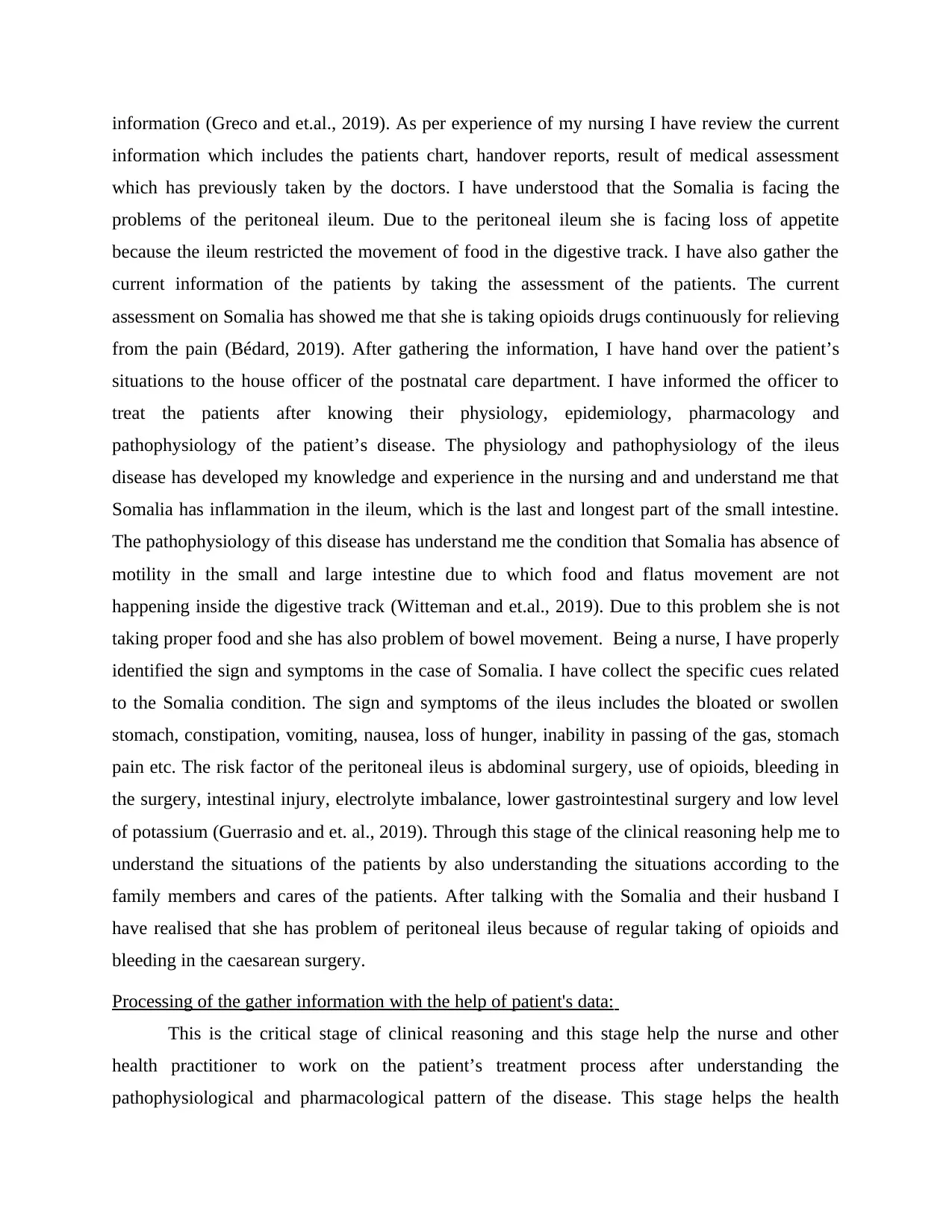
information (Greco and et.al., 2019). As per experience of my nursing I have review the current
information which includes the patients chart, handover reports, result of medical assessment
which has previously taken by the doctors. I have understood that the Somalia is facing the
problems of the peritoneal ileum. Due to the peritoneal ileum she is facing loss of appetite
because the ileum restricted the movement of food in the digestive track. I have also gather the
current information of the patients by taking the assessment of the patients. The current
assessment on Somalia has showed me that she is taking opioids drugs continuously for relieving
from the pain (Bédard, 2019). After gathering the information, I have hand over the patient’s
situations to the house officer of the postnatal care department. I have informed the officer to
treat the patients after knowing their physiology, epidemiology, pharmacology and
pathophysiology of the patient’s disease. The physiology and pathophysiology of the ileus
disease has developed my knowledge and experience in the nursing and and understand me that
Somalia has inflammation in the ileum, which is the last and longest part of the small intestine.
The pathophysiology of this disease has understand me the condition that Somalia has absence of
motility in the small and large intestine due to which food and flatus movement are not
happening inside the digestive track (Witteman and et.al., 2019). Due to this problem she is not
taking proper food and she has also problem of bowel movement. Being a nurse, I have properly
identified the sign and symptoms in the case of Somalia. I have collect the specific cues related
to the Somalia condition. The sign and symptoms of the ileus includes the bloated or swollen
stomach, constipation, vomiting, nausea, loss of hunger, inability in passing of the gas, stomach
pain etc. The risk factor of the peritoneal ileus is abdominal surgery, use of opioids, bleeding in
the surgery, intestinal injury, electrolyte imbalance, lower gastrointestinal surgery and low level
of potassium (Guerrasio and et. al., 2019). Through this stage of the clinical reasoning help me to
understand the situations of the patients by also understanding the situations according to the
family members and cares of the patients. After talking with the Somalia and their husband I
have realised that she has problem of peritoneal ileus because of regular taking of opioids and
bleeding in the caesarean surgery.
Processing of the gather information with the help of patient's data:
This is the critical stage of clinical reasoning and this stage help the nurse and other
health practitioner to work on the patient’s treatment process after understanding the
pathophysiological and pharmacological pattern of the disease. This stage helps the health
information which includes the patients chart, handover reports, result of medical assessment
which has previously taken by the doctors. I have understood that the Somalia is facing the
problems of the peritoneal ileum. Due to the peritoneal ileum she is facing loss of appetite
because the ileum restricted the movement of food in the digestive track. I have also gather the
current information of the patients by taking the assessment of the patients. The current
assessment on Somalia has showed me that she is taking opioids drugs continuously for relieving
from the pain (Bédard, 2019). After gathering the information, I have hand over the patient’s
situations to the house officer of the postnatal care department. I have informed the officer to
treat the patients after knowing their physiology, epidemiology, pharmacology and
pathophysiology of the patient’s disease. The physiology and pathophysiology of the ileus
disease has developed my knowledge and experience in the nursing and and understand me that
Somalia has inflammation in the ileum, which is the last and longest part of the small intestine.
The pathophysiology of this disease has understand me the condition that Somalia has absence of
motility in the small and large intestine due to which food and flatus movement are not
happening inside the digestive track (Witteman and et.al., 2019). Due to this problem she is not
taking proper food and she has also problem of bowel movement. Being a nurse, I have properly
identified the sign and symptoms in the case of Somalia. I have collect the specific cues related
to the Somalia condition. The sign and symptoms of the ileus includes the bloated or swollen
stomach, constipation, vomiting, nausea, loss of hunger, inability in passing of the gas, stomach
pain etc. The risk factor of the peritoneal ileus is abdominal surgery, use of opioids, bleeding in
the surgery, intestinal injury, electrolyte imbalance, lower gastrointestinal surgery and low level
of potassium (Guerrasio and et. al., 2019). Through this stage of the clinical reasoning help me to
understand the situations of the patients by also understanding the situations according to the
family members and cares of the patients. After talking with the Somalia and their husband I
have realised that she has problem of peritoneal ileus because of regular taking of opioids and
bleeding in the caesarean surgery.
Processing of the gather information with the help of patient's data:
This is the critical stage of clinical reasoning and this stage help the nurse and other
health practitioner to work on the patient’s treatment process after understanding the
pathophysiological and pharmacological pattern of the disease. This stage helps the health
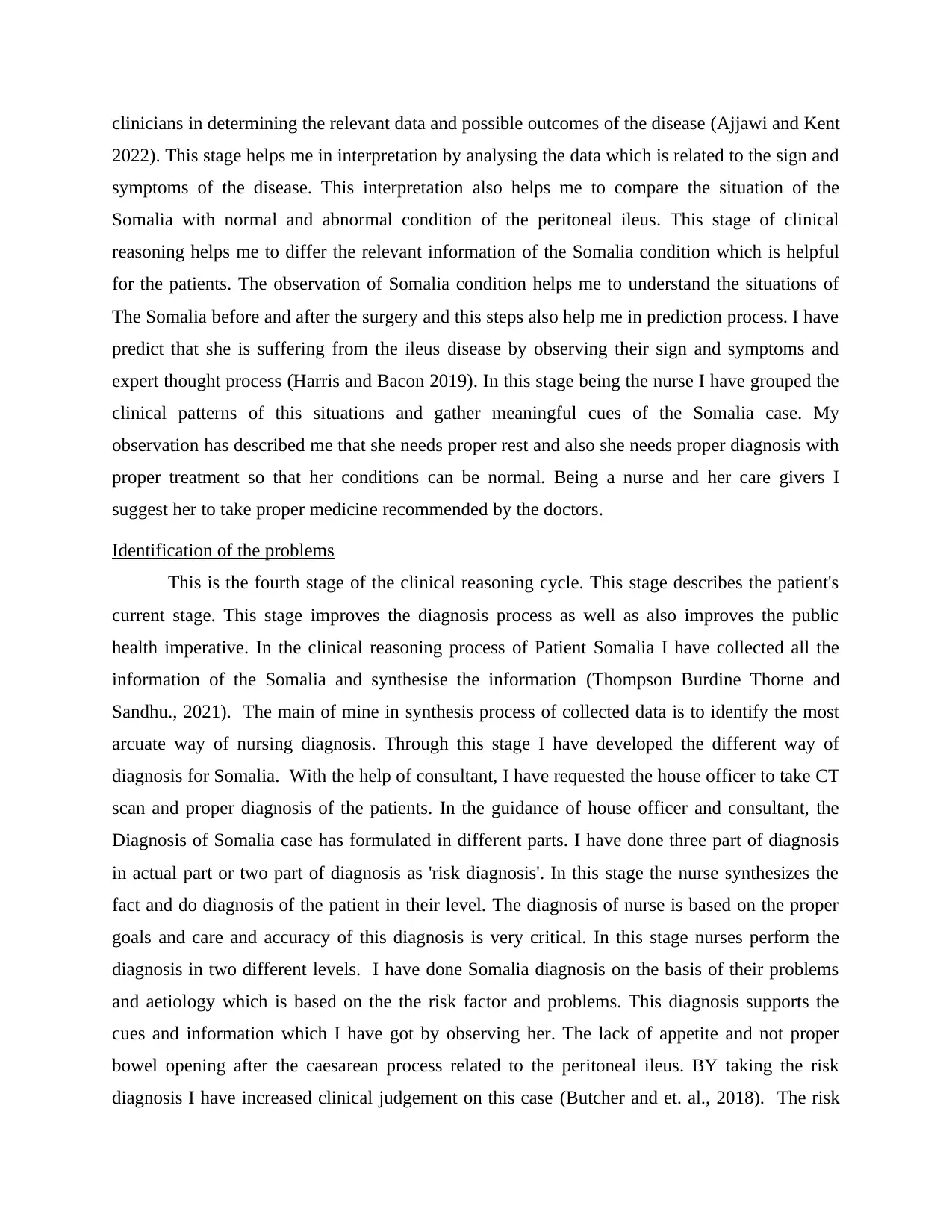
clinicians in determining the relevant data and possible outcomes of the disease (Ajjawi and Kent
2022). This stage helps me in interpretation by analysing the data which is related to the sign and
symptoms of the disease. This interpretation also helps me to compare the situation of the
Somalia with normal and abnormal condition of the peritoneal ileus. This stage of clinical
reasoning helps me to differ the relevant information of the Somalia condition which is helpful
for the patients. The observation of Somalia condition helps me to understand the situations of
The Somalia before and after the surgery and this steps also help me in prediction process. I have
predict that she is suffering from the ileus disease by observing their sign and symptoms and
expert thought process (Harris and Bacon 2019). In this stage being the nurse I have grouped the
clinical patterns of this situations and gather meaningful cues of the Somalia case. My
observation has described me that she needs proper rest and also she needs proper diagnosis with
proper treatment so that her conditions can be normal. Being a nurse and her care givers I
suggest her to take proper medicine recommended by the doctors.
Identification of the problems
This is the fourth stage of the clinical reasoning cycle. This stage describes the patient's
current stage. This stage improves the diagnosis process as well as also improves the public
health imperative. In the clinical reasoning process of Patient Somalia I have collected all the
information of the Somalia and synthesise the information (Thompson Burdine Thorne and
Sandhu., 2021). The main of mine in synthesis process of collected data is to identify the most
arcuate way of nursing diagnosis. Through this stage I have developed the different way of
diagnosis for Somalia. With the help of consultant, I have requested the house officer to take CT
scan and proper diagnosis of the patients. In the guidance of house officer and consultant, the
Diagnosis of Somalia case has formulated in different parts. I have done three part of diagnosis
in actual part or two part of diagnosis as 'risk diagnosis'. In this stage the nurse synthesizes the
fact and do diagnosis of the patient in their level. The diagnosis of nurse is based on the proper
goals and care and accuracy of this diagnosis is very critical. In this stage nurses perform the
diagnosis in two different levels. I have done Somalia diagnosis on the basis of their problems
and aetiology which is based on the the risk factor and problems. This diagnosis supports the
cues and information which I have got by observing her. The lack of appetite and not proper
bowel opening after the caesarean process related to the peritoneal ileus. BY taking the risk
diagnosis I have increased clinical judgement on this case (Butcher and et. al., 2018). The risk
2022). This stage helps me in interpretation by analysing the data which is related to the sign and
symptoms of the disease. This interpretation also helps me to compare the situation of the
Somalia with normal and abnormal condition of the peritoneal ileus. This stage of clinical
reasoning helps me to differ the relevant information of the Somalia condition which is helpful
for the patients. The observation of Somalia condition helps me to understand the situations of
The Somalia before and after the surgery and this steps also help me in prediction process. I have
predict that she is suffering from the ileus disease by observing their sign and symptoms and
expert thought process (Harris and Bacon 2019). In this stage being the nurse I have grouped the
clinical patterns of this situations and gather meaningful cues of the Somalia case. My
observation has described me that she needs proper rest and also she needs proper diagnosis with
proper treatment so that her conditions can be normal. Being a nurse and her care givers I
suggest her to take proper medicine recommended by the doctors.
Identification of the problems
This is the fourth stage of the clinical reasoning cycle. This stage describes the patient's
current stage. This stage improves the diagnosis process as well as also improves the public
health imperative. In the clinical reasoning process of Patient Somalia I have collected all the
information of the Somalia and synthesise the information (Thompson Burdine Thorne and
Sandhu., 2021). The main of mine in synthesis process of collected data is to identify the most
arcuate way of nursing diagnosis. Through this stage I have developed the different way of
diagnosis for Somalia. With the help of consultant, I have requested the house officer to take CT
scan and proper diagnosis of the patients. In the guidance of house officer and consultant, the
Diagnosis of Somalia case has formulated in different parts. I have done three part of diagnosis
in actual part or two part of diagnosis as 'risk diagnosis'. In this stage the nurse synthesizes the
fact and do diagnosis of the patient in their level. The diagnosis of nurse is based on the proper
goals and care and accuracy of this diagnosis is very critical. In this stage nurses perform the
diagnosis in two different levels. I have done Somalia diagnosis on the basis of their problems
and aetiology which is based on the the risk factor and problems. This diagnosis supports the
cues and information which I have got by observing her. The lack of appetite and not proper
bowel opening after the caesarean process related to the peritoneal ileus. BY taking the risk
diagnosis I have increased clinical judgement on this case (Butcher and et. al., 2018). The risk
⊘ This is a preview!⊘
Do you want full access?
Subscribe today to unlock all pages.

Trusted by 1+ million students worldwide

diagnosis is based on the risk factor and do not contains the sign and symptoms. I have
formulated the diagnosis of Peritoneal ileus which is based on the risk factor of surgery because
after surgery in many cases the ileus is common. The diagnosis which has done by me in the case
Somalia is systematic interpretation and this is based on the subjective and objective data.
Establishing the goals in the clinical reasoning of patients Somalia:
This stage of clinical reasoning helps the nurse and other health clinician regarding the
treatments of the patients according to their situations. The treatment of the patients is based on
time oriented goals. This is the stage in clinical reasoning suggest the health practitioner and
nurse regarding the measurable steps which should be taken by the nurse or other health
professionals. This stage also helps in finding the desired outcomes of the patients. I have
clarified my goal of care which is needed by the patients on urgent basis. I have taken the smart
goals which is specific, measurable, Achievable and timely. This smart goals help me to
understand the proper efficacy of the action. With the help of this stage of clinical reasoning,
firstly I have specified the urgent needs of patients (Alyari and Navimipour., 2018). As patients
are not proper taking care of their baby so I have appointed a nanny for the child. Another
achievable work which I have done in the patient’s treatment includes the proper observation of
bowel sounds. As the patients has not released flatus since 5 days so I will give intravenous
fluids and bowel decompression with the help of nasogastric tubes. I have also reduced the dose
of opioids and increase the antacids dose. The patients are also suffering from the abdomen
distension so I observe the patients supplement and must ensure other health practitioner that
there should be use of activated charcoal capsules and laxatives drugs for the treatment of the
Somalia. I have also established the goals with the help of other medical staff that there should
be proper and clean room of the caesarean ward. I have personally clean the wound of the
patients. I have suggested the Somalia that wear light, loose and comfortable cloth. The another
steps which is helpful for caesarean patients and I have suggested that do some kinds of exercise
which is helpful in fast recovery. I have suggested to do belly breathing and leg slide which help
the patients in mobilising process after their Caesarean (Duffy and et.al., 2020). I have suggested
the patients to take plenty of water and take more diet of high fibre which increase the bowel
movement of the patients after the surgery. I have formed the diet plan for the Somalia which
increase their taste and hunger. My diet plan has included the proteins and calcium rich food
which help the patient in healing the body. I have suggested the Somalia to take whole grains,
formulated the diagnosis of Peritoneal ileus which is based on the risk factor of surgery because
after surgery in many cases the ileus is common. The diagnosis which has done by me in the case
Somalia is systematic interpretation and this is based on the subjective and objective data.
Establishing the goals in the clinical reasoning of patients Somalia:
This stage of clinical reasoning helps the nurse and other health clinician regarding the
treatments of the patients according to their situations. The treatment of the patients is based on
time oriented goals. This is the stage in clinical reasoning suggest the health practitioner and
nurse regarding the measurable steps which should be taken by the nurse or other health
professionals. This stage also helps in finding the desired outcomes of the patients. I have
clarified my goal of care which is needed by the patients on urgent basis. I have taken the smart
goals which is specific, measurable, Achievable and timely. This smart goals help me to
understand the proper efficacy of the action. With the help of this stage of clinical reasoning,
firstly I have specified the urgent needs of patients (Alyari and Navimipour., 2018). As patients
are not proper taking care of their baby so I have appointed a nanny for the child. Another
achievable work which I have done in the patient’s treatment includes the proper observation of
bowel sounds. As the patients has not released flatus since 5 days so I will give intravenous
fluids and bowel decompression with the help of nasogastric tubes. I have also reduced the dose
of opioids and increase the antacids dose. The patients are also suffering from the abdomen
distension so I observe the patients supplement and must ensure other health practitioner that
there should be use of activated charcoal capsules and laxatives drugs for the treatment of the
Somalia. I have also established the goals with the help of other medical staff that there should
be proper and clean room of the caesarean ward. I have personally clean the wound of the
patients. I have suggested the Somalia that wear light, loose and comfortable cloth. The another
steps which is helpful for caesarean patients and I have suggested that do some kinds of exercise
which is helpful in fast recovery. I have suggested to do belly breathing and leg slide which help
the patients in mobilising process after their Caesarean (Duffy and et.al., 2020). I have suggested
the patients to take plenty of water and take more diet of high fibre which increase the bowel
movement of the patients after the surgery. I have formed the diet plan for the Somalia which
increase their taste and hunger. My diet plan has included the proteins and calcium rich food
which help the patient in healing the body. I have suggested the Somalia to take whole grains,
Paraphrase This Document
Need a fresh take? Get an instant paraphrase of this document with our AI Paraphraser
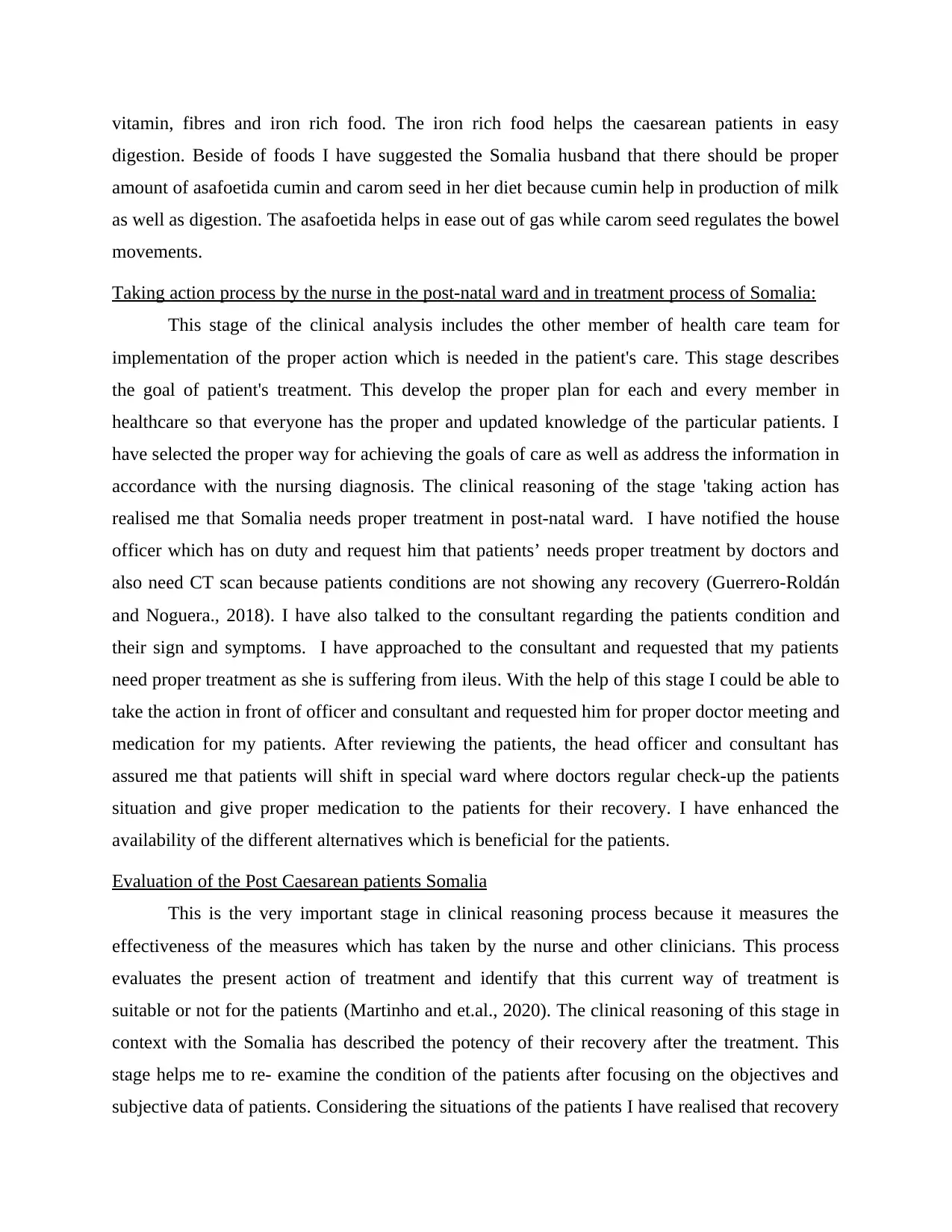
vitamin, fibres and iron rich food. The iron rich food helps the caesarean patients in easy
digestion. Beside of foods I have suggested the Somalia husband that there should be proper
amount of asafoetida cumin and carom seed in her diet because cumin help in production of milk
as well as digestion. The asafoetida helps in ease out of gas while carom seed regulates the bowel
movements.
Taking action process by the nurse in the post-natal ward and in treatment process of Somalia:
This stage of the clinical analysis includes the other member of health care team for
implementation of the proper action which is needed in the patient's care. This stage describes
the goal of patient's treatment. This develop the proper plan for each and every member in
healthcare so that everyone has the proper and updated knowledge of the particular patients. I
have selected the proper way for achieving the goals of care as well as address the information in
accordance with the nursing diagnosis. The clinical reasoning of the stage 'taking action has
realised me that Somalia needs proper treatment in post-natal ward. I have notified the house
officer which has on duty and request him that patients’ needs proper treatment by doctors and
also need CT scan because patients conditions are not showing any recovery (Guerrero-Roldán
and Noguera., 2018). I have also talked to the consultant regarding the patients condition and
their sign and symptoms. I have approached to the consultant and requested that my patients
need proper treatment as she is suffering from ileus. With the help of this stage I could be able to
take the action in front of officer and consultant and requested him for proper doctor meeting and
medication for my patients. After reviewing the patients, the head officer and consultant has
assured me that patients will shift in special ward where doctors regular check-up the patients
situation and give proper medication to the patients for their recovery. I have enhanced the
availability of the different alternatives which is beneficial for the patients.
Evaluation of the Post Caesarean patients Somalia
This is the very important stage in clinical reasoning process because it measures the
effectiveness of the measures which has taken by the nurse and other clinicians. This process
evaluates the present action of treatment and identify that this current way of treatment is
suitable or not for the patients (Martinho and et.al., 2020). The clinical reasoning of this stage in
context with the Somalia has described the potency of their recovery after the treatment. This
stage helps me to re- examine the condition of the patients after focusing on the objectives and
subjective data of patients. Considering the situations of the patients I have realised that recovery
digestion. Beside of foods I have suggested the Somalia husband that there should be proper
amount of asafoetida cumin and carom seed in her diet because cumin help in production of milk
as well as digestion. The asafoetida helps in ease out of gas while carom seed regulates the bowel
movements.
Taking action process by the nurse in the post-natal ward and in treatment process of Somalia:
This stage of the clinical analysis includes the other member of health care team for
implementation of the proper action which is needed in the patient's care. This stage describes
the goal of patient's treatment. This develop the proper plan for each and every member in
healthcare so that everyone has the proper and updated knowledge of the particular patients. I
have selected the proper way for achieving the goals of care as well as address the information in
accordance with the nursing diagnosis. The clinical reasoning of the stage 'taking action has
realised me that Somalia needs proper treatment in post-natal ward. I have notified the house
officer which has on duty and request him that patients’ needs proper treatment by doctors and
also need CT scan because patients conditions are not showing any recovery (Guerrero-Roldán
and Noguera., 2018). I have also talked to the consultant regarding the patients condition and
their sign and symptoms. I have approached to the consultant and requested that my patients
need proper treatment as she is suffering from ileus. With the help of this stage I could be able to
take the action in front of officer and consultant and requested him for proper doctor meeting and
medication for my patients. After reviewing the patients, the head officer and consultant has
assured me that patients will shift in special ward where doctors regular check-up the patients
situation and give proper medication to the patients for their recovery. I have enhanced the
availability of the different alternatives which is beneficial for the patients.
Evaluation of the Post Caesarean patients Somalia
This is the very important stage in clinical reasoning process because it measures the
effectiveness of the measures which has taken by the nurse and other clinicians. This process
evaluates the present action of treatment and identify that this current way of treatment is
suitable or not for the patients (Martinho and et.al., 2020). The clinical reasoning of this stage in
context with the Somalia has described the potency of their recovery after the treatment. This
stage helps me to re- examine the condition of the patients after focusing on the objectives and
subjective data of patients. Considering the situations of the patients I have realised that recovery
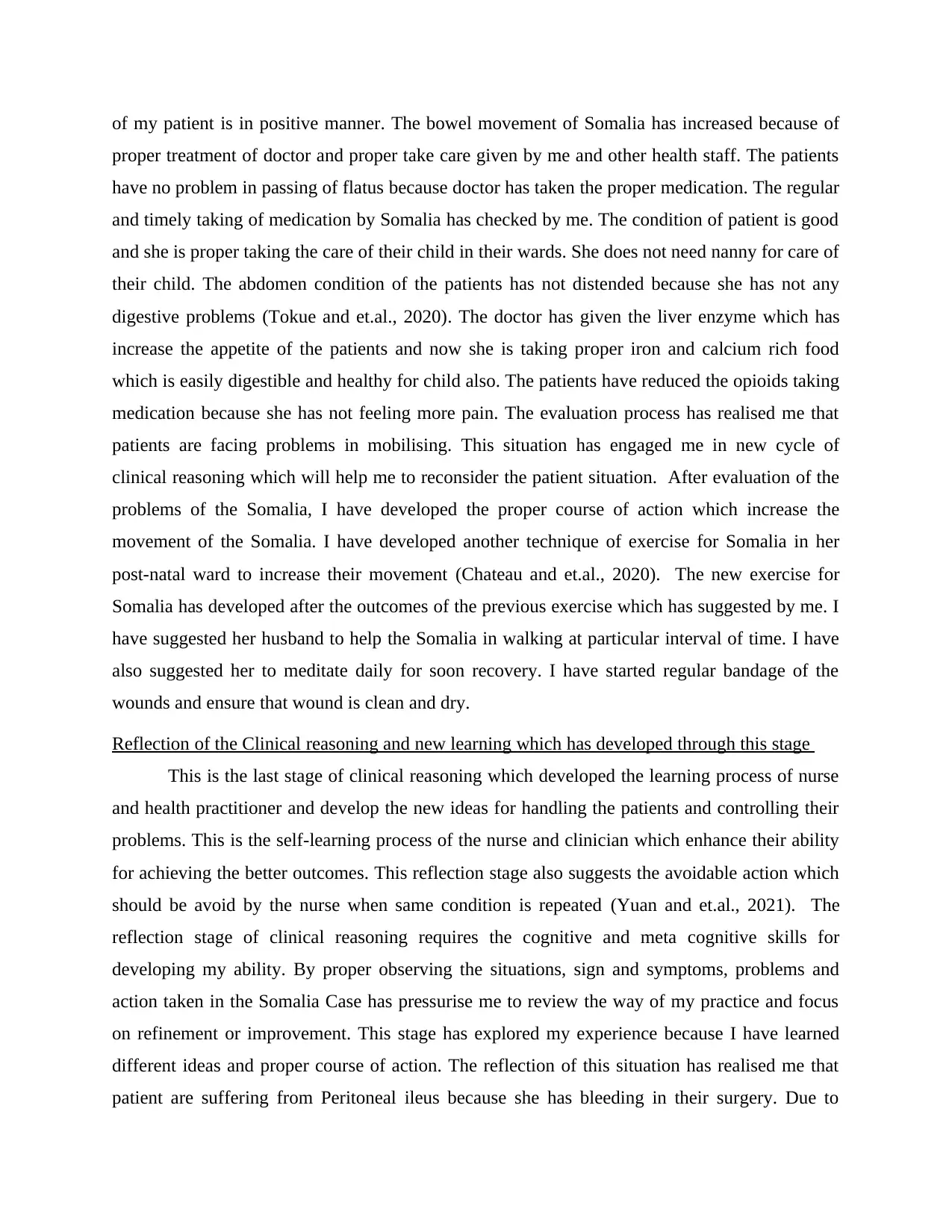
of my patient is in positive manner. The bowel movement of Somalia has increased because of
proper treatment of doctor and proper take care given by me and other health staff. The patients
have no problem in passing of flatus because doctor has taken the proper medication. The regular
and timely taking of medication by Somalia has checked by me. The condition of patient is good
and she is proper taking the care of their child in their wards. She does not need nanny for care of
their child. The abdomen condition of the patients has not distended because she has not any
digestive problems (Tokue and et.al., 2020). The doctor has given the liver enzyme which has
increase the appetite of the patients and now she is taking proper iron and calcium rich food
which is easily digestible and healthy for child also. The patients have reduced the opioids taking
medication because she has not feeling more pain. The evaluation process has realised me that
patients are facing problems in mobilising. This situation has engaged me in new cycle of
clinical reasoning which will help me to reconsider the patient situation. After evaluation of the
problems of the Somalia, I have developed the proper course of action which increase the
movement of the Somalia. I have developed another technique of exercise for Somalia in her
post-natal ward to increase their movement (Chateau and et.al., 2020). The new exercise for
Somalia has developed after the outcomes of the previous exercise which has suggested by me. I
have suggested her husband to help the Somalia in walking at particular interval of time. I have
also suggested her to meditate daily for soon recovery. I have started regular bandage of the
wounds and ensure that wound is clean and dry.
Reflection of the Clinical reasoning and new learning which has developed through this stage
This is the last stage of clinical reasoning which developed the learning process of nurse
and health practitioner and develop the new ideas for handling the patients and controlling their
problems. This is the self-learning process of the nurse and clinician which enhance their ability
for achieving the better outcomes. This reflection stage also suggests the avoidable action which
should be avoid by the nurse when same condition is repeated (Yuan and et.al., 2021). The
reflection stage of clinical reasoning requires the cognitive and meta cognitive skills for
developing my ability. By proper observing the situations, sign and symptoms, problems and
action taken in the Somalia Case has pressurise me to review the way of my practice and focus
on refinement or improvement. This stage has explored my experience because I have learned
different ideas and proper course of action. The reflection of this situation has realised me that
patient are suffering from Peritoneal ileus because she has bleeding in their surgery. Due to
proper treatment of doctor and proper take care given by me and other health staff. The patients
have no problem in passing of flatus because doctor has taken the proper medication. The regular
and timely taking of medication by Somalia has checked by me. The condition of patient is good
and she is proper taking the care of their child in their wards. She does not need nanny for care of
their child. The abdomen condition of the patients has not distended because she has not any
digestive problems (Tokue and et.al., 2020). The doctor has given the liver enzyme which has
increase the appetite of the patients and now she is taking proper iron and calcium rich food
which is easily digestible and healthy for child also. The patients have reduced the opioids taking
medication because she has not feeling more pain. The evaluation process has realised me that
patients are facing problems in mobilising. This situation has engaged me in new cycle of
clinical reasoning which will help me to reconsider the patient situation. After evaluation of the
problems of the Somalia, I have developed the proper course of action which increase the
movement of the Somalia. I have developed another technique of exercise for Somalia in her
post-natal ward to increase their movement (Chateau and et.al., 2020). The new exercise for
Somalia has developed after the outcomes of the previous exercise which has suggested by me. I
have suggested her husband to help the Somalia in walking at particular interval of time. I have
also suggested her to meditate daily for soon recovery. I have started regular bandage of the
wounds and ensure that wound is clean and dry.
Reflection of the Clinical reasoning and new learning which has developed through this stage
This is the last stage of clinical reasoning which developed the learning process of nurse
and health practitioner and develop the new ideas for handling the patients and controlling their
problems. This is the self-learning process of the nurse and clinician which enhance their ability
for achieving the better outcomes. This reflection stage also suggests the avoidable action which
should be avoid by the nurse when same condition is repeated (Yuan and et.al., 2021). The
reflection stage of clinical reasoning requires the cognitive and meta cognitive skills for
developing my ability. By proper observing the situations, sign and symptoms, problems and
action taken in the Somalia Case has pressurise me to review the way of my practice and focus
on refinement or improvement. This stage has explored my experience because I have learned
different ideas and proper course of action. The reflection of this situation has realised me that
patient are suffering from Peritoneal ileus because she has bleeding in their surgery. Due to
⊘ This is a preview!⊘
Do you want full access?
Subscribe today to unlock all pages.

Trusted by 1+ million students worldwide
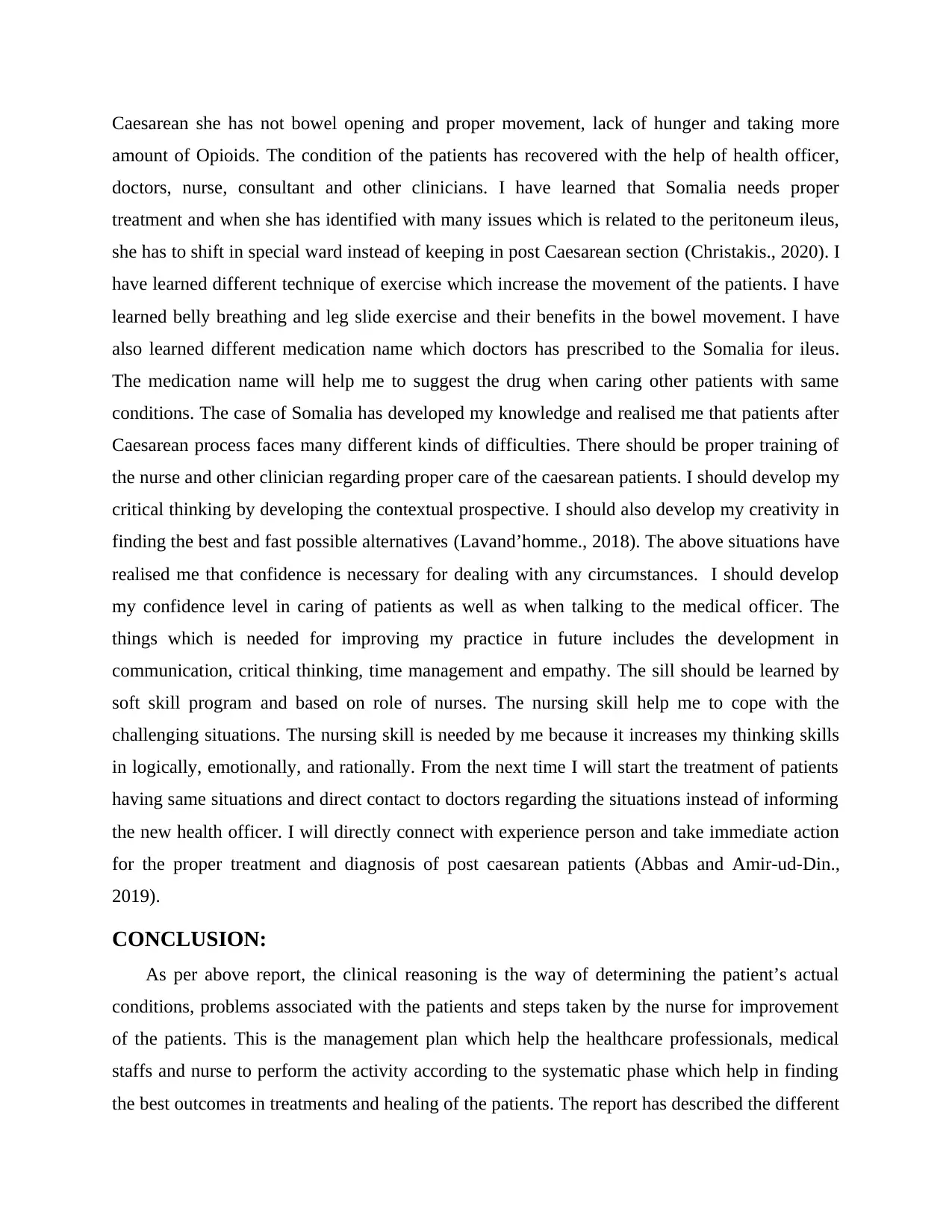
Caesarean she has not bowel opening and proper movement, lack of hunger and taking more
amount of Opioids. The condition of the patients has recovered with the help of health officer,
doctors, nurse, consultant and other clinicians. I have learned that Somalia needs proper
treatment and when she has identified with many issues which is related to the peritoneum ileus,
she has to shift in special ward instead of keeping in post Caesarean section (Christakis., 2020). I
have learned different technique of exercise which increase the movement of the patients. I have
learned belly breathing and leg slide exercise and their benefits in the bowel movement. I have
also learned different medication name which doctors has prescribed to the Somalia for ileus.
The medication name will help me to suggest the drug when caring other patients with same
conditions. The case of Somalia has developed my knowledge and realised me that patients after
Caesarean process faces many different kinds of difficulties. There should be proper training of
the nurse and other clinician regarding proper care of the caesarean patients. I should develop my
critical thinking by developing the contextual prospective. I should also develop my creativity in
finding the best and fast possible alternatives (Lavand’homme., 2018). The above situations have
realised me that confidence is necessary for dealing with any circumstances. I should develop
my confidence level in caring of patients as well as when talking to the medical officer. The
things which is needed for improving my practice in future includes the development in
communication, critical thinking, time management and empathy. The sill should be learned by
soft skill program and based on role of nurses. The nursing skill help me to cope with the
challenging situations. The nursing skill is needed by me because it increases my thinking skills
in logically, emotionally, and rationally. From the next time I will start the treatment of patients
having same situations and direct contact to doctors regarding the situations instead of informing
the new health officer. I will directly connect with experience person and take immediate action
for the proper treatment and diagnosis of post caesarean patients (Abbas and Amir-ud-Din.,
2019).
CONCLUSION:
As per above report, the clinical reasoning is the way of determining the patient’s actual
conditions, problems associated with the patients and steps taken by the nurse for improvement
of the patients. This is the management plan which help the healthcare professionals, medical
staffs and nurse to perform the activity according to the systematic phase which help in finding
the best outcomes in treatments and healing of the patients. The report has described the different
amount of Opioids. The condition of the patients has recovered with the help of health officer,
doctors, nurse, consultant and other clinicians. I have learned that Somalia needs proper
treatment and when she has identified with many issues which is related to the peritoneum ileus,
she has to shift in special ward instead of keeping in post Caesarean section (Christakis., 2020). I
have learned different technique of exercise which increase the movement of the patients. I have
learned belly breathing and leg slide exercise and their benefits in the bowel movement. I have
also learned different medication name which doctors has prescribed to the Somalia for ileus.
The medication name will help me to suggest the drug when caring other patients with same
conditions. The case of Somalia has developed my knowledge and realised me that patients after
Caesarean process faces many different kinds of difficulties. There should be proper training of
the nurse and other clinician regarding proper care of the caesarean patients. I should develop my
critical thinking by developing the contextual prospective. I should also develop my creativity in
finding the best and fast possible alternatives (Lavand’homme., 2018). The above situations have
realised me that confidence is necessary for dealing with any circumstances. I should develop
my confidence level in caring of patients as well as when talking to the medical officer. The
things which is needed for improving my practice in future includes the development in
communication, critical thinking, time management and empathy. The sill should be learned by
soft skill program and based on role of nurses. The nursing skill help me to cope with the
challenging situations. The nursing skill is needed by me because it increases my thinking skills
in logically, emotionally, and rationally. From the next time I will start the treatment of patients
having same situations and direct contact to doctors regarding the situations instead of informing
the new health officer. I will directly connect with experience person and take immediate action
for the proper treatment and diagnosis of post caesarean patients (Abbas and Amir-ud-Din.,
2019).
CONCLUSION:
As per above report, the clinical reasoning is the way of determining the patient’s actual
conditions, problems associated with the patients and steps taken by the nurse for improvement
of the patients. This is the management plan which help the healthcare professionals, medical
staffs and nurse to perform the activity according to the systematic phase which help in finding
the best outcomes in treatments and healing of the patients. The report has described the different
Paraphrase This Document
Need a fresh take? Get an instant paraphrase of this document with our AI Paraphraser
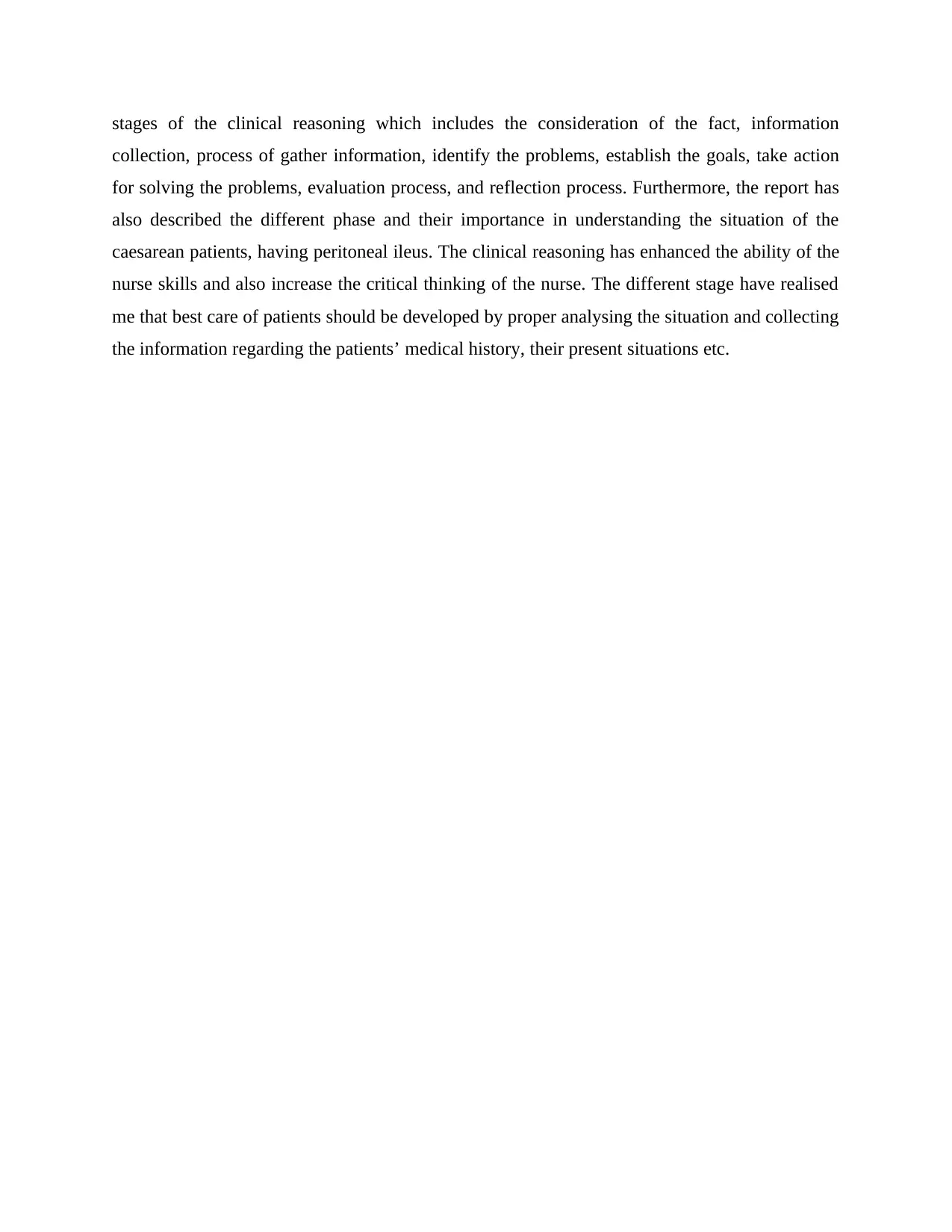
stages of the clinical reasoning which includes the consideration of the fact, information
collection, process of gather information, identify the problems, establish the goals, take action
for solving the problems, evaluation process, and reflection process. Furthermore, the report has
also described the different phase and their importance in understanding the situation of the
caesarean patients, having peritoneal ileus. The clinical reasoning has enhanced the ability of the
nurse skills and also increase the critical thinking of the nurse. The different stage have realised
me that best care of patients should be developed by proper analysing the situation and collecting
the information regarding the patients’ medical history, their present situations etc.
collection, process of gather information, identify the problems, establish the goals, take action
for solving the problems, evaluation process, and reflection process. Furthermore, the report has
also described the different phase and their importance in understanding the situation of the
caesarean patients, having peritoneal ileus. The clinical reasoning has enhanced the ability of the
nurse skills and also increase the critical thinking of the nurse. The different stage have realised
me that best care of patients should be developed by proper analysing the situation and collecting
the information regarding the patients’ medical history, their present situations etc.
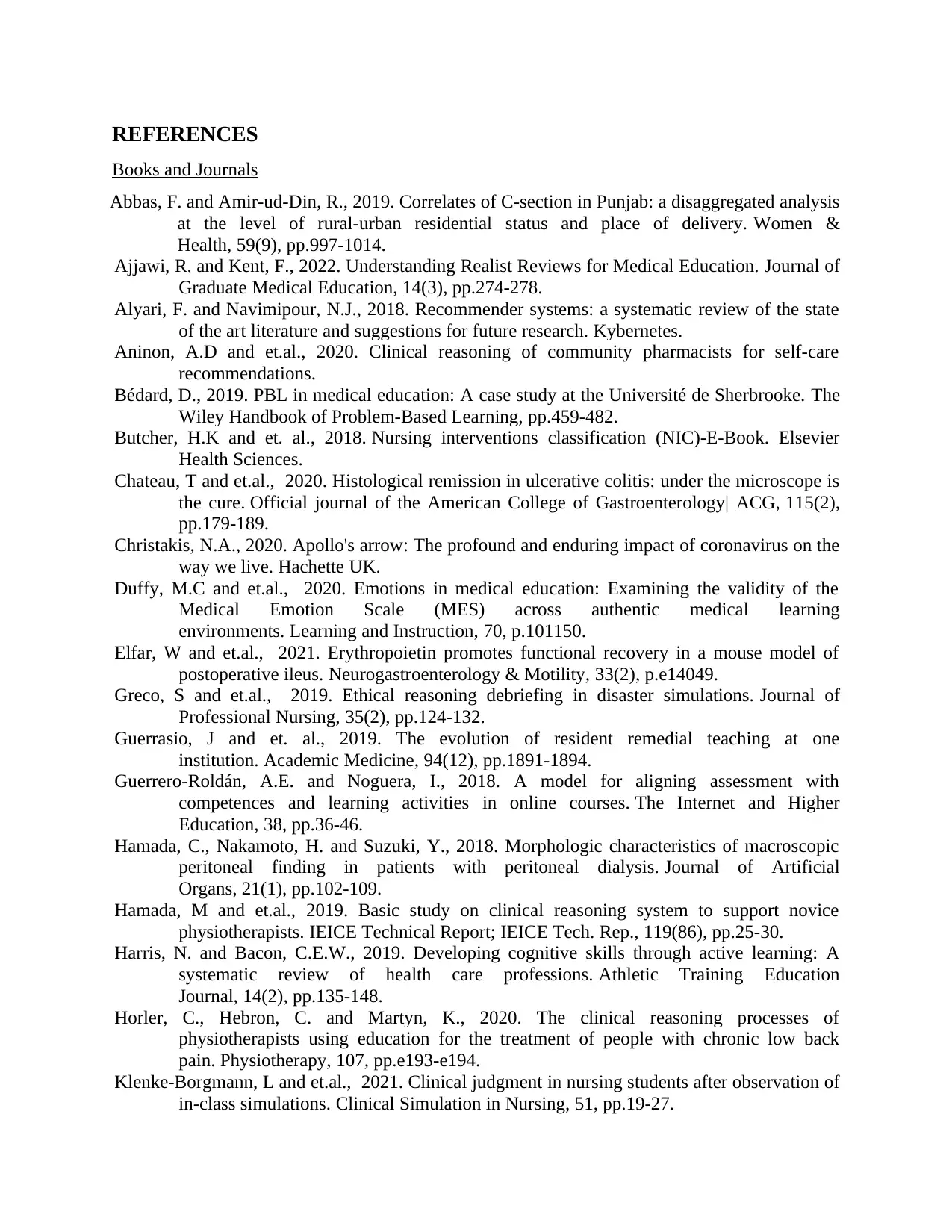
REFERENCES
Books and Journals
Abbas, F. and Amir-ud-Din, R., 2019. Correlates of C-section in Punjab: a disaggregated analysis
at the level of rural-urban residential status and place of delivery. Women &
Health, 59(9), pp.997-1014.
Ajjawi, R. and Kent, F., 2022. Understanding Realist Reviews for Medical Education. Journal of
Graduate Medical Education, 14(3), pp.274-278.
Alyari, F. and Navimipour, N.J., 2018. Recommender systems: a systematic review of the state
of the art literature and suggestions for future research. Kybernetes.
Aninon, A.D and et.al., 2020. Clinical reasoning of community pharmacists for self-care
recommendations.
Bédard, D., 2019. PBL in medical education: A case study at the Université de Sherbrooke. The
Wiley Handbook of Problem‐Based Learning, pp.459-482.
Butcher, H.K and et. al., 2018. Nursing interventions classification (NIC)-E-Book. Elsevier
Health Sciences.
Chateau, T and et.al., 2020. Histological remission in ulcerative colitis: under the microscope is
the cure. Official journal of the American College of Gastroenterology| ACG, 115(2),
pp.179-189.
Christakis, N.A., 2020. Apollo's arrow: The profound and enduring impact of coronavirus on the
way we live. Hachette UK.
Duffy, M.C and et.al., 2020. Emotions in medical education: Examining the validity of the
Medical Emotion Scale (MES) across authentic medical learning
environments. Learning and Instruction, 70, p.101150.
Elfar, W and et.al., 2021. Erythropoietin promotes functional recovery in a mouse model of
postoperative ileus. Neurogastroenterology & Motility, 33(2), p.e14049.
Greco, S and et.al., 2019. Ethical reasoning debriefing in disaster simulations. Journal of
Professional Nursing, 35(2), pp.124-132.
Guerrasio, J and et. al., 2019. The evolution of resident remedial teaching at one
institution. Academic Medicine, 94(12), pp.1891-1894.
Guerrero-Roldán, A.E. and Noguera, I., 2018. A model for aligning assessment with
competences and learning activities in online courses. The Internet and Higher
Education, 38, pp.36-46.
Hamada, C., Nakamoto, H. and Suzuki, Y., 2018. Morphologic characteristics of macroscopic
peritoneal finding in patients with peritoneal dialysis. Journal of Artificial
Organs, 21(1), pp.102-109.
Hamada, M and et.al., 2019. Basic study on clinical reasoning system to support novice
physiotherapists. IEICE Technical Report; IEICE Tech. Rep., 119(86), pp.25-30.
Harris, N. and Bacon, C.E.W., 2019. Developing cognitive skills through active learning: A
systematic review of health care professions. Athletic Training Education
Journal, 14(2), pp.135-148.
Horler, C., Hebron, C. and Martyn, K., 2020. The clinical reasoning processes of
physiotherapists using education for the treatment of people with chronic low back
pain. Physiotherapy, 107, pp.e193-e194.
Klenke-Borgmann, L and et.al., 2021. Clinical judgment in nursing students after observation of
in-class simulations. Clinical Simulation in Nursing, 51, pp.19-27.
Books and Journals
Abbas, F. and Amir-ud-Din, R., 2019. Correlates of C-section in Punjab: a disaggregated analysis
at the level of rural-urban residential status and place of delivery. Women &
Health, 59(9), pp.997-1014.
Ajjawi, R. and Kent, F., 2022. Understanding Realist Reviews for Medical Education. Journal of
Graduate Medical Education, 14(3), pp.274-278.
Alyari, F. and Navimipour, N.J., 2018. Recommender systems: a systematic review of the state
of the art literature and suggestions for future research. Kybernetes.
Aninon, A.D and et.al., 2020. Clinical reasoning of community pharmacists for self-care
recommendations.
Bédard, D., 2019. PBL in medical education: A case study at the Université de Sherbrooke. The
Wiley Handbook of Problem‐Based Learning, pp.459-482.
Butcher, H.K and et. al., 2018. Nursing interventions classification (NIC)-E-Book. Elsevier
Health Sciences.
Chateau, T and et.al., 2020. Histological remission in ulcerative colitis: under the microscope is
the cure. Official journal of the American College of Gastroenterology| ACG, 115(2),
pp.179-189.
Christakis, N.A., 2020. Apollo's arrow: The profound and enduring impact of coronavirus on the
way we live. Hachette UK.
Duffy, M.C and et.al., 2020. Emotions in medical education: Examining the validity of the
Medical Emotion Scale (MES) across authentic medical learning
environments. Learning and Instruction, 70, p.101150.
Elfar, W and et.al., 2021. Erythropoietin promotes functional recovery in a mouse model of
postoperative ileus. Neurogastroenterology & Motility, 33(2), p.e14049.
Greco, S and et.al., 2019. Ethical reasoning debriefing in disaster simulations. Journal of
Professional Nursing, 35(2), pp.124-132.
Guerrasio, J and et. al., 2019. The evolution of resident remedial teaching at one
institution. Academic Medicine, 94(12), pp.1891-1894.
Guerrero-Roldán, A.E. and Noguera, I., 2018. A model for aligning assessment with
competences and learning activities in online courses. The Internet and Higher
Education, 38, pp.36-46.
Hamada, C., Nakamoto, H. and Suzuki, Y., 2018. Morphologic characteristics of macroscopic
peritoneal finding in patients with peritoneal dialysis. Journal of Artificial
Organs, 21(1), pp.102-109.
Hamada, M and et.al., 2019. Basic study on clinical reasoning system to support novice
physiotherapists. IEICE Technical Report; IEICE Tech. Rep., 119(86), pp.25-30.
Harris, N. and Bacon, C.E.W., 2019. Developing cognitive skills through active learning: A
systematic review of health care professions. Athletic Training Education
Journal, 14(2), pp.135-148.
Horler, C., Hebron, C. and Martyn, K., 2020. The clinical reasoning processes of
physiotherapists using education for the treatment of people with chronic low back
pain. Physiotherapy, 107, pp.e193-e194.
Klenke-Borgmann, L and et.al., 2021. Clinical judgment in nursing students after observation of
in-class simulations. Clinical Simulation in Nursing, 51, pp.19-27.
⊘ This is a preview!⊘
Do you want full access?
Subscribe today to unlock all pages.

Trusted by 1+ million students worldwide
1 out of 13
Related Documents
Your All-in-One AI-Powered Toolkit for Academic Success.
+13062052269
info@desklib.com
Available 24*7 on WhatsApp / Email
![[object Object]](/_next/static/media/star-bottom.7253800d.svg)
Unlock your academic potential
Copyright © 2020–2025 A2Z Services. All Rights Reserved. Developed and managed by ZUCOL.




